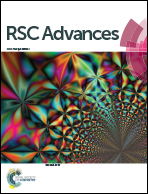Novel photochromic and electrochromic diarylethenes bearing triphenylamine units†
Abstract
Six novel photochromic and electrochromic diarylethenes containing triphenylamine units were synthesized by the McMurry reaction. The properties of photochromism, electrochromism, fluorescence and electrochemistry were investigated in detail. The results showed that these compounds exhibited reversible photochromism, changing from colorless to yellow after irradiation with 302 nm UV light both in solution and in PMMA amorphous film. When arriving at the photostationary state, the fluorescent intensity was quenched to about 40%. In the cyclic voltammetry curves, there were a reversible redox couple and one or two irreversible oxidation peaks. The potential of the reversible oxidation peak is adopted as the excitation voltage of electrochromism. The electrochromic devices could be simulated with an equivalent circuit, R(CR)(CR), by electrochemical impedance spectroscopy, and the transformation between colorless and blue was realized, which required 8.6 to 12.1 s for color switching and 8.9 to 12.8 s for bleaching. The reflectance minima of these compounds are in the range from 709.7 to 781.7 nm after coloring. The results showed that diarylethenes containing triphenylamine units possessed both photochromic and electrochromic properties.


 Please wait while we load your content...
Please wait while we load your content...